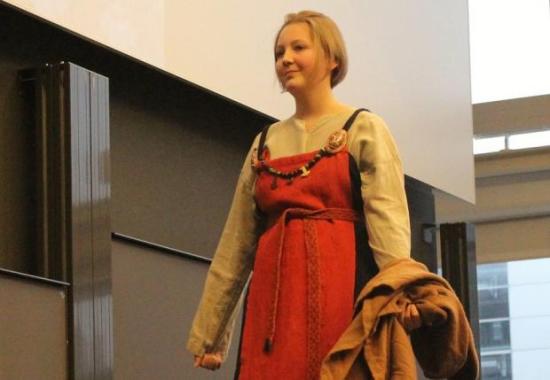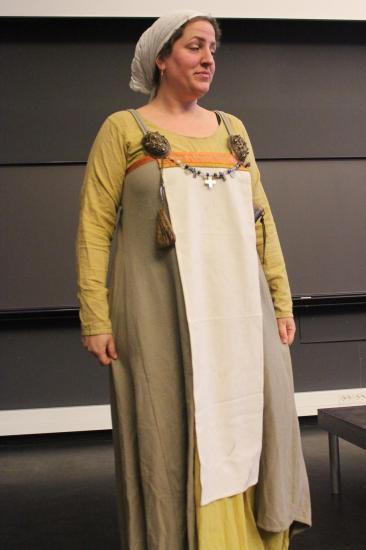The Vikings were skilled warriors, traders, and explorers, but a more fashionable side might also have existed.
Johan Skov Andersen
Source - http://sciencenordic.com/fashionable-vikings-loved-colours-fur-and-silk?

A complete female outfit in one of the Viking's most stylish colours, red. Shell-shaped brooches hold the dress in place. These went out of fashion midway through the Viking Age. (Photos by Johan Skov Andersen)
The year is 873 and Frida is deciding what to wear. Her new red dress is finally ready, as are her freshly polished shell-shaped brooches designed to hold it in place at her shoulders. The dress is the newest cut in Viking fashion.

A complete female outfit with linen undergarments or smock, a strap dress with shell-shaped brooches and a headscarf
Of course, we don’t know exactly how such a scenario played out. Nevertheless, to a Viking woman, Frida’s dress in vibrant red with matching brooches could have been hugely popular. In fact, red and blue were among the most popular colours in the Viking Age.
But did the Vikings really have fashion on the mind?
"Yes," says Ulla Mannering from the Centre for Textile Research at the National Museum in Copenhagen.
Fashion in Viking times was different from how we perceive it today, where the wardrobe changes from year to year, she explains, but we can see a form of 'fashion' from the archaeological finds from that time.
"The Vikings had trends and tendencies that we today might call fashion. Viking fashion changes slowly through time. It does not mean that they threw out all their old clothes, but we do see new colours, decorations, or costume shapes materialise over time, "said Mannering.
Exclusive materials reserved for the rich
Our knowledge of Viking fashion comes entirely from the tombs of rich Vikings and tells us little about how poorer people in society would have dressed, explains Mannering.
"What we call fashion are their symbols of high status. Overall, it appears that the ordinary Vikings would have been dressed in something similar, though less luxurious and without the gold, silver, fur, and silk. But the elements would have been roughly the same. Styles of high-status outfits probably greatly influenced styles of garments made further down the social hierarchy," says Mannering.
The Vikings, who had the means to do so, were therefore not afraid to wear extravagant clothes, made with expensive materials. But what do we know about Viking clothes in general?
Wool, linen, and layers
Ulla Mannering explains that in Viking times there were differences between how men and women dressed.
A typical costume for a woman consisted of a linen undergarment, covered by a long woollen dress or skirt down to the feet. Dresses often had straps and were held in place across the chest with shell-shaped brooches.

A colourful dress with matching shell-shaped brooches that hold the dress in place over the shoulders.
Researchers have also discovered that some dresses had fitted sleeves. Outerwear was usually a cloak, closed at the front of the chest, typically worn with a small hat or a headscarf.

A suggestion of how the famous female Viking fighters might have looked
PART.2